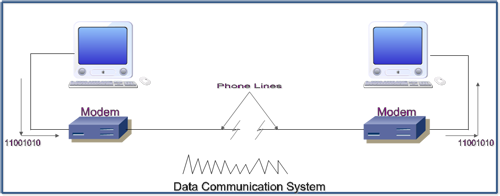A circuit is a path between two or more points along which an electrical current flows. In data communication, we may consider a circuit as a specific path between two or more points along which signals can be carried. The signals may be analog, binary or digital. It has been shown in the Figures, wherein the link between PC and modem, link between modem and CTO and so on constitutes a circuit.

The circuit may be a physical path consisting of one or more wires. It may also be wireless. A network which may be wired or wifeless is an arrangement of circuits consisting of a number of intermediate switches. A circuit maybe classified based upon its uses. In case of dial up connection or leased line connection, a circuit is basically dedicated to user or owner. Again, in case of dial up connection it is reserved for the user only for a limited period, the period ‘for which the connection is invoked. On the other hand, leased line arrangement, a circuit is reserved in advance and can only be used by the owner of the circuit.

Further, connection between two or more points may be established virtually unlike the connection made by dial up and leased line as physical in nature. Therefore, circuit maybe defined as Virtual Circuit (VC) based upon the type and nature of the connection. A virtual circuit may be defined as logical path between two or more points. It is selected out of many possible physical paths available between those points. However, the connection is not guaranteed. Therefore, it seems like a fixed physical path. A permanent connection is ensured using Permanent Virtual Circuit (PVC) which provides a guaranteed connection between two or more points when needed without having to reserve or commit to a specific physical path in advance. A Switched Virtual Circuit (SVC) is similar to a permanent virtual circuit, but allows users to dial in to the network of virtual circuits.
The difference between circuit and channel basically lies in the way it is utilized. A channel is a portion of the circuit that is used to transmit a single voice or data signal, which can be either a 4 kHz signal in analog transmission or 64 Kb/s signal in digital transmission. In Figure, communication between two CTOs takes place in digital transmission mode and therefore, constitutes a channel of 64 kHz bandwidth. Similarly, communication between modem and CTO takes place on analog channel of 4 KHz bandwidth.
A circuit may contain many channels together. In case of Integrated Services Digital Network (ISDN) basic rate interface (BRI) service is supporting three multiplexed channels. These are divided in two service channels at 64 Kb/s each and a 16 Kb/s signaling channel. Likewise, A Digital Signal I (DSI) circuit supports 24 64-Kb/s channels, while a DS3 circuit supports 512 64-Kb/s channels. These numbers of channels on a single circuit are possible because of multiplexing techniques.
 Dinesh Thakur holds an B.C.A, MCDBA, MCSD certifications. Dinesh authors the hugely popular
Dinesh Thakur holds an B.C.A, MCDBA, MCSD certifications. Dinesh authors the hugely popular